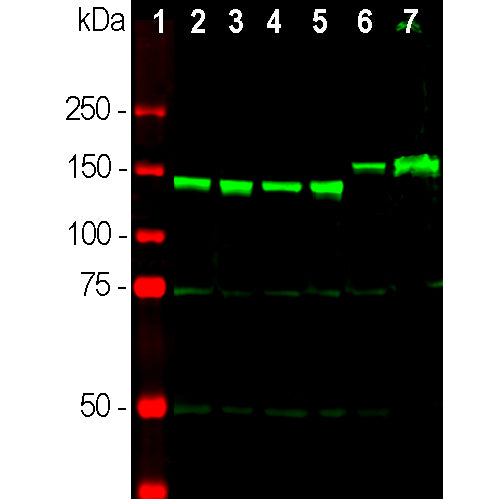


EnCor Biotechnology
Rabbit Polyclonal Antibody to Neurofilament NF-M (Nfm, NEFM), Cat# RPCA-NF-M
Description
The RPCA-NF-M antibody was made against a recombinant human NF-M C-terminal region amino acids 741-916. This region is similar the C-terminal rat NF-M, amino acids 677-845, and a similar antibody against this region was described previously (7). This region is very highly conserved in protein sequence across species boundaries and contains some interesting peptide repeats of currently unknown function (8). As shown here, the current antibody works well for western blotting, IF, ICC and IHC including on formalin fixed paraffin embedded material, to view select the "Additional Data" tab. Also available from EnCor are a chicken polyclonal and a widely used mouse monoclonal antibody to the same immunogen CPCA-NF-M and MCA-3H11 respectively.
- Cell Structure Marker
- Cell Type Marker
- Cytoskeletal Marker
- Epitope Mapped Antibodies
- Immunohistochemistry Verified
- Rabbit Polyclonal Antibodies
Add a short description for this tabbed section
| Immunogen: | Recombinant fusion protein containing the extreme C-terminal segment of human NF-M, amino acids 741-916 |
| HGNC Name: | NEFM |
| UniProt: | P07197 |
| Molecular Weight: | 145-160kDa |
| Host: | Rabbit |
| Species Cross-Reactivity: | Human, rat, mouse, cow, pig, horse, chicken |
| RRID: | AB_2572366 |
| Format: | Serum plus 5mM NaN3 |
| Applications: | WB, IF/ICC, IHC, ABC |
| Recommended Dilutions: | WB: 1:1,000-5,000. IF/ICC: 1:2,000. IHC: 1:1,000-1:2,500. |
| Storage: | Store at 4°C for short term, for longer term store at -20°C. Stable for 12 months from date of receipt. |
Neurofilaments are the 10nm or intermediate filament proteins found specifically in neurons, and are composed predominantly of three major proteins called NF-L, NF-M and NF-H. NF-M is the neurofilament middle or medium molecular weight polypeptide and runs on SDS-PAGE gels at 145-160kDa, with some species variability, though the real molecular weight is ~105kDa. The major function of neurofilaments is likely to control the diameter of large axons (1). Antibodies to NF-M such as RPCA-NF-M are useful for identifying neuronal cells and their processes in tissue sections and in cell culture. NF-M antibodies can also be useful to visualize neurofilament rich accumulations seen in many neurological diseases, such as Amyotrophic Lateral Sclerosis (a.k.a. Lou Gehrig’s disease) and Alzheimer’s disease (2-4).Much recent evidence has suggested that the detection of NF-L and NF-H in blood and CSF might be a useful prognostic or diagnostic biomarkers of neuronal damage and degeneration associated with a variety of CNS pathologies (5,6). The potential utility of NF-M in this fashion has not to date been examined.

Chromogenic immunostaining of a formalin fixed paraffin embedded human cerebellum section with rabbit pAb to NF-M, RPCA-NF-M, dilution 1:2,000, detected with DAB (brown) using Vector Labs ImmPRESS method and reagents with citrate buffer retrieval. Hematoxylin (blue) was used as the counterstain. RPCA-NF-M labels the perikarya and dendrites of Purkinje cells and the projections of neuronal cells within the granular layer. This antibody performs well in testing with both 4% PFA and standard NBF fixed rat, mouse, and human tissues. Mouse select image for larger view.

Chromogenic immunostaining of a formalin fixed paraffin embedded human cerebellum section with rabbit pAb to NF-M, RPCA-NF-M, dilution 1:1,000, detected with DAB (brown) using Vector Labs ImmPRESS method and reagents with citrate buffer retrieval. Hematoxylin (blue) was used as the counterstain. In this image, RPCA-NF-M labels the perikarya and dendrites of Purkinje cells and the projections of neuronal cells within the granular layer. This antibody performs well in testing with both 4% PFA and standard NBF fixed rat, mouse, and human tissues. Mouse select image for larger view.

Immunofluorescent analysis of rat cerebellum section stained with rabbit pAb to NF-M, RPCA-NF-M, dilution 1:2,000 in red, and costained with mouse mAb to GAP43, MCA-3H14, dilution 1:2,000 in green. Following transcardial perfusion of rat with 4% paraformaldehyde, brain was post fixed for 24 hours, cut to 45μM, and free-floating sections were stained with the above antibodies. The RPCA-NF-M antibody strongly labels neuronal processes throughout the cerebellum, while the GAP43 antibody stains predominantly synaptic regions in the molecular layer.
1. Hoffman et al. Neurofilament gene expression:a major determinant of axonal caliber. PNAS 84:3472-6 (1987).
2. Perrot R, et al. Review of the Multiple Aspects of Neurofilament Functions, and their Possible Contribution to Neurodegeneration. Mol. Neurobiol. 38:27-65 (2008).
3. Lépinoux-Chambaud C. Eyer J. Review on intermediate filaments of the nervous system and their pathological alterations. Histochem. Cell Biol. 140:13-22 (2013).
4. Liu Q. et al. Neurofilamentopathy in Neurodegenerative Diseases. Open Neurol. J. 5:58–62 (2011).
5. Bacioglu M, et al. Neurofilament light chain in blood and CSF as marker of disease progression in mouse models and in neurodegenerative diseases. Neuron 91:56-66 (2016).
6. Shaw G. The use and potential of pNF-H as a general blood biomarker of axonal loss: an immediate application for CNS injury. in Brain Neurotrauma: Molecular, Neuropsychological, and Rehabilitation Aspects. CRC Press/Taylor & Francis Chapter 21 (2015).
7. Harris J, Ayyub C. and Shaw G. A molecular dissection of the carboxyterminal tails of the major neurofilament subunits NF-M and NF-H. J. Neurosci. Res. 30:47-62 (1991).
8. Shaw G. Identification of previously unrecognized sequence motifs at the extreme carboxyterminus of the neurofilament subunit NF-M. BBRC 14;162:294-9 (1989).
Add a short description for this tabbed section





